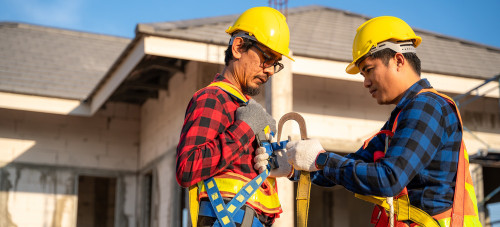Understanding Fall Hazards in Construction
Let me tell you, if you review OSHA and accident and fatality statistics, there have been a fair share related to falls. It's no joke - falls are still the leading cause of fatalities in construction and understanding these hazards is crucial for keeping everyone safe on the job site.
First things first, let's talk about the types of fall hazards we face daily. Trust me, they're everywhere if you know where to look!
Unprotected edges are probably the most obvious culprit. If you're looking down from a upper floor with nothing but air between you and the ground. It's a wake-up call, that's for sure! Edges are particularly dangerous on roofs, balconies, and mezzanines.
Then there are those sneaky floor openings. One accident involved a guy stepping backwards into an uncovered shaft - luckily, he was wearing his harness! Elevator shafts, skylights, and even those small openings for plumbing or electrical work can be deadly if we're not paying attention.
A very common scenario deals with unstable surfaces. Ever tried walking on a roof with a 45-degree pitch during a light drizzle? It's like trying to dance on a greased watermelon! Slippery surfaces, loose materials, and unstable scaffolding are accidents waiting to happen.
Now, let's chat about those high-risk areas that keep safety managers up at night (and trust me, I've had my share of sleepless nights!):
1. Roofing work:
Whether it's residential or commercial, working on roofs is always a high-wire act.
2. Steel erection:
I've got mad respect for ironworkers - they're basically acrobats with tool belts.
3. Scaffolding:
It might look stable, but one loose connection can turn it into a house of cards.
4. Aerial lifts:
Great for reaching high places, but they can tip if you're not careful.
5. Excavations and trenches:
The risk of cave-ins adds another layer of danger to fall hazards.
But here's the kicker - it's not just about the obvious stuff. There are tons of factors that can turn a regular day into a disaster waiting to happen. Weather is a big one. One example was a worker in Chicago, the wind was so strong it nearly blew him off his feet on the 30th floor. Rain, ice, and extreme temperatures can all make surfaces treacherous.
Lack of training is another huge issue. Newbies walk onto job sites thinking they're invincible, only to freeze up when they get to a high spot. Proper training isn't just about checking a box - it's about building confidence and instilling good habits.
And then there's equipment failure! A harness at quick glance may look perfectly fine, but when inspected closely, a failure or break in material can spell disaster. Regular equipment checks aren't just good practice - they're life-savers.
So next time you're on a site, take a moment to really look around. Identify those fall hazards, respect them, and most importantly, do something about them. Trust me, your future self (and your crew) will thank you for it!
Remember, in construction, gravity is always on the job. But with the right knowledge and precautions, we can make sure everyone goes home safely at the end of the day. Stay safe out there, folks!

